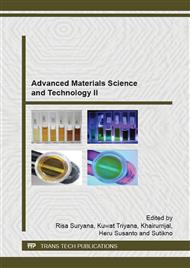p.114
p.119
p.123
p.127
p.131
p.135
p.140
p.147
p.151
Magneto-Conductance Effect of Natural Porphyrin Thin Films Fabricated by Spin Coated Method
Abstract:
We present magneto conductivity measurements in natural porphyrin thin films in magnetic fields of 100 Oe at room-temperature. The films used in this experiment were isolated from natural spirulina sp by chromatography procedure with n-hexane. Each layer fabricated by spin coater methods with rotation speed of 2500 rpm for 60 second is followed post heating at temperature of 60°C for 300 second. The procedure is repeated N times. Magneto-conductance effect is presented at room temperature with induce magnetic field in plane of films. The results show that ratio magneto-conductance decreases with the increase of voltage provided. The magneto-conductance ratio increase with the increase of N repetition number. Finally, both the results indicate that magneto-conductance effect could be realized due to annihilation of carrier charge.
Info:
Periodical:
Pages:
131-134
Citation:
Online since:
August 2015
Authors:
Price:
Сopyright:
© 2015 Trans Tech Publications Ltd. All Rights Reserved
Share:
Citation:


